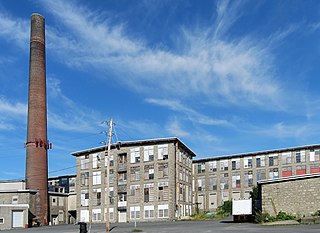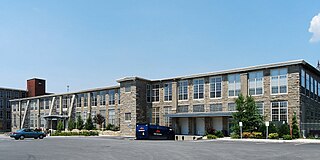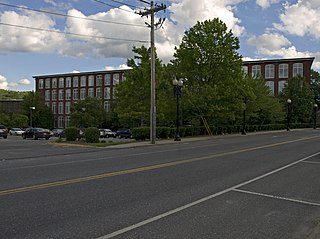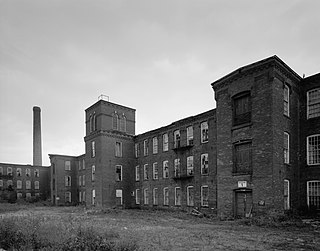
The Bigelow Carpet Company Woolen Mills are a historic mill complex on Main Street in Clinton, Massachusetts. The sprawling mill complex was built or expanded by the Bigelow Carpet Company, one of Clinton's leading business for much of the 19th and early 20th centuries. The complex was listed on the National Register of Historic Places in 1983. It continues to be adaptively reused by smaller businesses.

The Hayward Mill is a historic mill complex at the junction of North and Cook Streets, on the Mumford River in Douglas, Massachusetts. The site, with an industrial history dating to the 18th century, is populated by a series of connected buildings dating to 1880 or later. The mill was the first financial successful textile operation in Douglas, and was operated until the 1960s. The mill complex was listed on the National Register of Historic Places in 1991. It has been converted to residential use.

Chace Mills is a historic textile mill complex on Lewiston and Salem Streets in Fall River, Massachusetts. Built in 1872, it is one of the city's most visible historic mills, with a particularly fine Italianate stair tower. The complex was added to the National Register of Historic Places in 1983.

The Lower Highlands Historic District encompasses one of the oldest residential areas of Fall River, Massachusetts. The district is roughly bounded by Cherry, Main, Winter, and Bank Streets, and is located just east of the Downtown Fall River Historic District and directly south of the Highlands Historic District. This area was settled by 1810, has architecture tracing the city's growth as a major industrial center. The historic district was added to the National Register of Historic Places in 1984.

Stafford Mills is an historic textile mill complex located on County Street in Fall River, Massachusetts, USA. Founded in 1872, it is a well-preserved late-19th century textile complex, typical of the mills built in Fall River during its period of most rapid growth. It is noted in particular for its exceptionally fine Romanesque brick office building. The complex was added to the National Register of Historic Places in 1983.

Barnard Mills is an historic textile mill at 641-657 Quarry Street in Fall River, Massachusetts. Developed beginning in 1874, it was the first mill to use ring spinners instead of mule spinners, and was a major local employer until its closure in 1939. The complex has been redeveloped as a commercial retail space called Tower Mill. The mill was added to the National Register of Historic Places in 1983.

Charlton Mill is a historic textile mill at 109 Howe Street in Fall River, Massachusetts. Built in 1911, it is the last of the city's stone mill buildings to be built, and the first to feature the dual sources of steam and electrical power. The mill was added to the National Register of Historic Places in 1983.

Crescent Mill, later Merchant Mill No. 3, is a historic cotton textile mill located at 54 Front Street in Fall River, Massachusetts. Built in 1872 during an industrial construction boom, it is one of the city's finest examples of Italianate mill architecture. The building was added to the National Register of Historic Places in 1983. It is now used for other light industrial purposes.

King Philip Mills is an historic cotton mill complex located at 372 Kilburn Street in Fall River, Massachusetts. Developed between 1871 and 1892, it was historically one of the city's largest mills, and its building inventory is still largely complete. The complex was added to the National Register of Historic Places in 1983.

Clover Leaf Mills is a historic cotton textile mill complex located at 1 & 21 Father DeValles Boulevard in Fall River, Massachusetts. Begun in 1884, the mill is a good example of 1880s industrial architecture. The site was added to the National Register of Historic Places in 1983.

Cornell Mills is an historic cotton textile mill on Alden Street in Fall River, Massachusetts. Built in 1890, it is a well-preserved example of late 19th-century industrial mill architecture in stone. The mill complex was added to the National Register of Historic Places in 1983. On February 26, 2016, a developer has bought the property with the intent to convert the mill into middle-class residential housing.

Pilgrim Mills is an historic textile mill located at 847 Pleasant Street in Fall River, Massachusetts. The mill was built in 1911 from red brick and was the first mill in the city powered entirely by electricity, provided from the local grid. It was one of the last mill complexes built in the city. The property was listed on the National Register of Historic Places in 1983.

The Berkshire Mill No. 1 is a historic mill complex on Hoosac Street in the center of Adams, Massachusetts. Built in 1895 by the locally prominent Plunkett family, it is an important surviving reminder of the town's industrial textile past. Now converted into mixed residential and commercial use, it was listed on the National Register of Historic Places in 1982.

The Merrell Tavern, known more recently as the Merrell Inn, is a historic tavern at 1565 Pleasant Street in South Lee, Massachusetts. Built in 1794 as a residence, it has served for most of two centuries as a local traveler's accommodation, and retains fine Federal period architectural details. It was added to the National Register of Historic Places in 1972. It continues to serve its historic function, and is now operated as a bed and breakfast inn.

The Mill Village Historic District is a historic district encompassing a well-preserved 19th century mill village in Williamstown, Massachusetts. It is located on Cole Avenue and other streets east of Cole and south of the Hoosac River, which provided the mill's power. The complex dates to the mid-19th century, and includes tenement houses, housing for supervisors and specialty personnel, as well as a surviving mill building. The village district was listed on the National Register of Historic Places in 1983.

Monument Mills are historic textile mills at Park and Front Streets in the Housatonic village of Great Barrington, Massachusetts. Developed beginning in the mid-19th century, they were a major American producer of jacquard fabrics, operating until 1955. The mill complexes were listed on the National Register of Historic Places in 1983. Today, some parts of the complex houses artists and small businesses.

The Renfrew Mill No. 2 was a historic mill complex at 217 Columbia Street in Adams, Massachusetts. Most of its buildings were built between 1867 and 1878, and were brick buildings with Italianate styling. They were built by the Renfrew Manufacturing Company, a textile manufacturer, to replace an earlier complex further down Columbia Street that had been demolished. The property was acquired by the Arnold Print Works in 1928. The mill was the town's largest employer for much of the second half of the 19th century.

Otis Company Mill No. 1 is a historic mill on E. Main Street in Ware, Massachusetts, United States. Built in 1845, it is one of the best-preserved stone mills in western Massachusetts, and a rare surviving example of a large mill from the pre-turbine phase of industrialization. The building was listed on the National Register of Historic Places in 1982. It was further listed as a contributing property to the Ware Millyard Historic District in 1986.

The Old Mill Site Historic District in Hatfield, Massachusetts encompasses the site of a late 19th century mill. It is one of only two such sites in the town. The centerpiece of the district is the former Shattuck Gun Factory building, which in 1989 housed newspaper offices and in 2006 a bed and breakfast. The district, which was listed on the National Register of Historic Places in 1982, includes three other elements: an 1891 Warren pony truss bridge across the Mill River, now closed to traffic, and a machine shop and garage, both built in 1886. The district was also included in the larger Mill-Prospect Street Historic District in 2002.

The Pleasant Street School is an historic school building at 54 Pleasant Street in Spencer, Massachusetts. The two story Victorial Eclectic brick building was designed by the Worcester firm of Fuller & Delano, and built in 1883 by J. D. Morton. It follows a cruciform plan, with a large pavilion projecting from the main facade. The paired main entrances are on the sides of this projecting section.
























